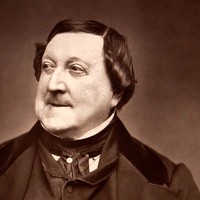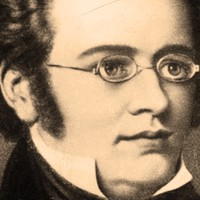Schubert’s Little C Major Symphony



Wolfgang Amadeus Mozart’s sinfonia concertantes blend the style of the Classical solo concerto with the instrumental configurations of earlier Baroque orchestral works, such as George Frideric Handel’s concerto grossi and Johann Sebastian Bach’s Brandenburg concertos.
Concerto-like works for a group of two or more solo instruments and orchestra were quite popular when Mozart visited Mannheim and Paris, leading him to compose several such works in the late 1770s and early 1780s.
A version of Mozart’s Sinfonia concertante for Winds and Orchestra was prepared for a performance at the Parisian Concert Spirituel in 1778, but the piece was unexpectedly removed from the concert program at the last minute and was never played. The parts were not copied and were perhaps lost. However, an anonymous copy of a work believed to be the lost Parisian concerto by Mozart was discovered in 1869 in the collection of Mozart’s first biographer Otto Jahn. This is the version of the work that is played today.
There has been much scholarly debate about the authenticity and origins of the Jahn manuscript, particularly since it is scored for solo oboe, solo clarinet, solo horn, solo bassoon, and orchestra. Mozart’s original manuscript was specifically composed for four of his friends who played flute, oboe, horn, and bassoon. Additionally, there are many unanswered questions about how an anonymous copy of a modified version of a lost work from Paris might end up nearly a century later in a collection in Berlin.
Although the official Köchel catalog of Mozart’s works designates this sinfonia concertante as spurious, the piece certainly demonstrates many quintessential characteristics of Mozart’s works. In particular, Mozart was regarded for his brilliant solo wind writing, which is evidenced throughout the piece. The horn soars in its high register; the bassoon functions beautifully as a bass, tenor, and melodic instrument; the clarinet has multiple velvety lines; and the oboe’s melodies are penetrating and expressive.
All three movements of this sinfonia concertante are in E-flat major, leading some to conclude that the work is not Mozart’s, since most of his multi-movement works have movements in different tonal centers. The first movement features a well-crafted cadenza that tastefully incorporates all four soloists, and the second movement demonstrates exquisite melodic writing. The third movement is a series of ten variations on a cheerful theme, one phrase of which is a direct quotation of the second theme from the first movement.
Paula Maust ©2022
 Listen to Audio
Listen to Audio
Gioachino Rossini was the greatest opera composer of his generation. From his first comic farce, written at age 18, to his crowning work for the stage, William Tell, he dashed off an astounding 39 operas in 19 years. Then, at the height of his fame and creative powers, Rossini withdrew almost entirely from composing. He never wrote another opera in his remaining 40 years.
Il signor Bruschino was already the eighth opera created by Rossini, who was just shy of his 21st birthday, and it marked the fourth commission in the span of a year from Venice’s Teatro San Moisè. As with his previous works for Venice, this new one-act opera took the form of a comic farce, featuring a small cast of performers who were as much comedians as singers.
The complete title of this opera hints at the basic outline of the story—Mr. Bruschino, or the Son by Accident. Florville wants to marry his beloved Sophia, but she is already promised to the son of one Mr. Bruschino. Florville pretends to be the younger Mr. Bruschino, but everything goes awry when the real Bruschino senior arrives and finds this other suitor impersonating his son!
The most distinctive sound in this playful overture is the rhythmic tapping of violin bows. (In Rossini’s day they probably tapped the shades of their candle holders, but now metal music stands substitute nicely.) The effect is surprising and whimsical, but the musical logic behind it is quite sturdy, with the rhythms mimicking themes already heard from the orchestra.
Aaron Grad ©2017

In 1817, German composer Franz Schubert had left his teaching position at his father’s school and was working to establish his career as a freelance composer in Vienna. Neapolitan operas, particularly those by Gioachino Rossini, were wildly popular in Vienna at the time. Eager to compose pieces that would sell to the general public, Schubert wrote a number of works emulating the Italian style, including his Symphony No. 6.
Symphony No. 6 was written between October 1817 and February 1818. The piece is sometimes called “The Little C Major” in order to differentiate it from his later “Great C Major” Symphony No. 9. None of Schubert’s symphonies were publicly performed or published until after his death in 1828. In fact, Symphony No. 6 was only premiered in December 1828 because the Society of the Friends of Music in Vienna found Schubert’s Symphony No. 9 to be too difficult to learn in time for their upcoming performance. At the last minute, they chose to play Symphony No. 6 instead.
Although Symphony No. 6 demonstrates Schubert’s brilliant ability to craft exquisite melodies, the work has received decidedly mixed reviews. A critic at the premiere wrote that it was “a fine, diligently crafted work whose most appealing movements are the Scherzo and the Finale.” Later in the century, however, musicologist Ernest Newman wrote: “Is the succession of charming little tunes known as Schubert’s sixth symphony a festival work? Not, I grieve to say, for me. When one knows in advance exactly what will happen four bars hence…the suspense of waiting for the expected becomes positively nerve-racking.”
After a slow, expectant Adagio introduction, the Symphony moves into a cheerful, quick Allegro with Italianate themes. The conversational dialogue between the solo woodwinds and strings is a convention at which Schubert excelled, and the movement ends with noisy grandeur similar to a Rossini opera overture. The sentimental Andante opens with a lilting theme, which is then contrasted with a more intense section that features insistent triplets.
As the nineteenth century progressed, the traditional Minuet and Trio that was typically found in the third movement of symphonies was often replaced with a scherzo. Schubert’s symphonies illustrate this stylistic trend as well, with Symphony No. 6 being his first symphony to have a scherzo for the third movement. Many have compared this particular movement from Symphony No. 6 to Beethoven’s symphonic scherzos. Schubert’s Scherzo is quite energetic and playful, qualities one expects in these witty, joke-like movements. Symphony No. 6 concludes with a bright, animated Finale with clever orchestration.
Paula Maust ©2022
Get driving directions and find nearby parking.
Find dining options close to the venue.
View seating charts to find out where you'll be seating.
Get driving directions and find nearby parking.
Find dining options close to the venue.
View seating charts to find out where you'll be seating.
